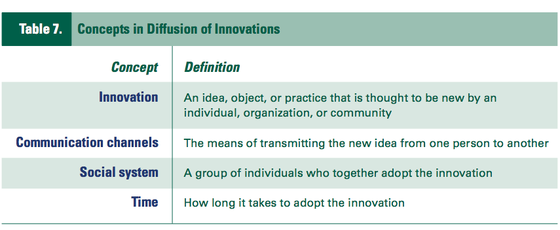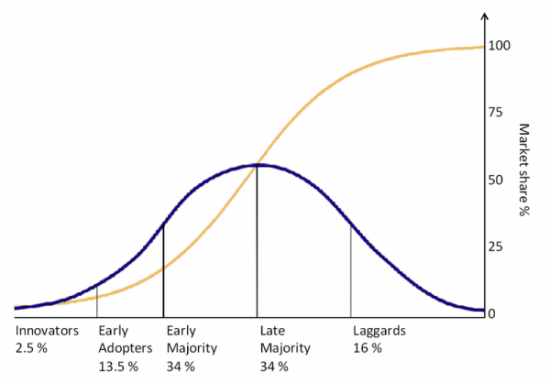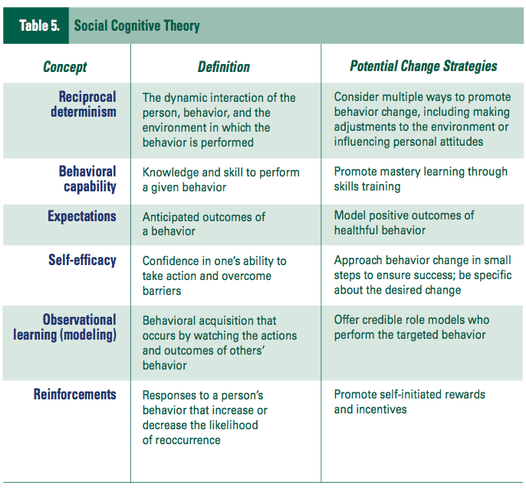Prevention Theory
Frequently Used Behavior Change Models and Theories
Socio-ecological Model
Spectrum of Prevention
Diffusion of Innovations
According to the National Cancer Institute, the “Diffusion of Innovations Theory” addresses how ideas, products, and social practices that are perceived as “new” spread throughout a society or from one society to another. According to the late E.M. Rogers, diffusion of innovations is “the process by which an innovation is communicated through certain channels over time among the members of a social system.” Diffusion Theory has been used to study the adoption of a wide range of health behaviors and programs, including condom use, smoking cessation, and use of new tests and technologies by health practitioners.”
Source: National Cancer Institute, Theory at a Glance: A Guide for Health Promotion Practice, 2006
Rogers explains that there are different adopter categories that require different strategies to get each group to adopt the innovation. The categories are:
innovators, early adopters, early majority, late majority, and laggards, as shown in this chart: From Wikimedia Commons
From Wikimedia Commons
Stages of Change
The Stages of Change Model was developed by Prochaska and DiClemente, and was originally based on extensive interviews with people who had overcome addictions to nicotine. This model is also know as the Transtheoretical Model, because it spanned so many different theories. This model recognizes that behavior change is a process rather than an event.
Stages
- Precontemplation: No intention to change and unaware of problem or risk.
- Contemplation: Aware of problem. Would consider change, but no specific plans or commitment.
- Preparation: Plan to take action soon.
- Action: Take concrete steps to address problem, but behavior change is not consistent yet.
- Maintenance
- Relapse: Revert to old behaviors.
- Termination: Complete confidence in ability to maintain behavior change forever in any situation.
- Reference: Prochaska, J. O. (1979). Systems of psychotherapy: A transtheoretical analysis. Homewood, IL: Dorsey Press.
Social Cognitive Theory
Behavior is shaped by the interaction of environment, the desired behavior and the characteristics of the person. The National Cancer Institute states that, “According to [Social Cognitive Theory], three main factors affect the likelihood that a person will change a health behavior: (1) self-efficacy, (2) goals, and (3) outcome expectancies. If individuals have a sense of personal agency or self- efficacy, they can change behaviors even when faced with obstacles. If they do not feel that they can exercise control over their health behavior, they are not motivated to act, or to persist through challenges. As a person adopts new behaviors, this causes changes in both the environment and in the person. Behavior is not simply a product of the environment and the person, and environment is not simply a product of the person and behavior.”

Source: [[www.cancer.gov/PDF/481f5d53-63df-41bc-bfaf…/TAAG3.pdf]]
Additional Recommended Readings on Theory, by Level of Socio-Ecological Model
- “Behavioral and Social Science Theory,” Jeannine Coreil. Good general overview.
- “Selected Planning Frameworks, Social Science Theories, and Models of Change,” National Cancer Institute. Most relevant section starts below the drawing of the framework.
- “Health Promotion 101, Module 4: Theories,” Ontario Health Promotion Resource Center. More detailed.
- “Theory at a Glance: A guide for health promotion practice,” National Cancer Institute. Comprehensive guide.
Theoretical Approaches and Frameworks for Violence Against Women Prevention – a Bibliography
Overview of Prevention Theories
- Chamberlain, Linda and Rivers. Julie Ann (2008). A Prevention Primer for Domestic Violence: Terminology, Tools, and the Public Health Approach. VAWnet: The National Online Resource Center on Violence Against Women.
- Cohen, L., & Chehimi, S. (2007). Beyond brochures. The imperative for primary prevention. In L. Cohen, V. Chavez & Sana Chehimi (Eds.) Prevention is primary. Strategies for Community Well-being. (pp. 3-23). San Francisco: John Wiley & Sons.
- Cohen, L., Davis, R. & Graffunder, C. (2006). Before it occurs: Primary prevention of intimate partner violence and abuse. In P. Salber & E. Taliferro (Eds.) The Physician’s Guide to Intimate Partner Violence and Abuse. (pp. 89-100) Volcano, CA:Volcano Press.
- Sexual Violence and the Spectrum of Prevention: Towards a Community Solution By Rachel Davis, Lisa Fujie Parks, and Larry Cohen (Prevention Institute). July 2006.
- Kelly, Liz, (2005). Promising Practices addressing sexual violence. Expert Group Meeting, Violence Against Women: Good practices in combating and eliminating violence against women, UN Division for the Advancement of Women and UN Office on Drugs and Crime, 17-20 May, Vienna, Austria.
- McDonnell, Karen A., Jessica G. Burke, Andrea Carlson Gielen, and Patricia J. O’Campo. (2006). Intimate Partner Violence. In Gielen, A. C., Sleet, D. A., & DiClemente, R. J. (Eds.). (2006). Injury and violence prevention: Behavioral science theories, methods and applications. San Francisco: Jossey-Bass (pp. 323-346).
- Prevention Institute (Lisa Fujie Parks, Larry Cohen, and Nicole Kravitz-Wirtz). (2007). Poised for Prevention: Advancing Promising Approaches to Primary Prevention of Intimate Partner Violence. Prevention Institute.
- VicHealth. (2007). Preventing violence before it occurs: A framework and background paper to guide the primary prevention of violence against women in Victoria. Melbourne: Victorian Health Promotion Foundation (VicHealth).
- Whitaker, D. J., Baker, C. K., and Arias, I. (2007). Interventions to prevent intimate partner violence. In L. S. Doll, S. Bonzo, J. Mercy, & D. Sleet (eds.), Handbook of injury and violence prevention (pp. 203-221). New York: Springer.
Reviews of Prevention Programs
Several researchers have conducted reviews of literature on violence against women prevention programs. These searches are often limited to published evidence-based practices.
- An Evidence-Based Review of Sexual Assault Preventive Intervention Programs By Shannon Morrison, Jennifer Hardison, Anita Mathew, & Joyce O’Neil. September 2004.
- Report Describing Projects Designed to Prevent First-Time Male Perpetration of Sexual Violence By Monique Clinton-Sherrod, Deborah Gibbs, Amy Vincus, Sean Squire, Connie Cignetti (RTI International) and Kristianna Pettibone, James Igoe (The MayaTech Corporation). April 2003.
- Anderson, Linda A., and Susan C. Whiston. (2005). Sexual Assault Education Programs: A Meta-Analytic Examination Of Their Effectiveness. Psychology of Women Quarterly, December, Vol. 29 Issue 4.
- Bachar, K., and M.P. Koss. (2001). From prevalence to prevention: Closing the gap between what we know about rape and what we do. In: Sourcebook on Violence Against Women. Renzetti C, Edleson J, Bergen RK, editors, Thousand Oaks, CA: Sage.
- Berkowitz, A.D. (2001). Critical Elements of Sexual Assault Prevention and Risk Reduction Programs for Men and Women. In: C. Kilmartin, Sexual Assault in Context: Teaching College Men About Gender. Holmes Beach: Learning Publications.
- Centers for Disease Control and Prevention. (2006). Preventing Violence Against Women: Program activities guide.
- Dahlberg, L.L., and A. Butchart. (2005). State of the science: Violence prevention efforts in developing and developed countries. Int J Inj Contr Saf Promot., Jun; 12(2):93-104.*
- Kilmartin, C., and J. Allison. (2007). Men’s Violence Against Women: Theory, Research, and Activism. Mahwah, NJ: Lawrence Erlbaum.
- Lonsway, Kimberly A., Victoria L. Banyard, Alan D. Berkowitz, Christine A. Gidycz, Jackson T. Katz, Mary P. Koss, Paul A. Schewe, and Sarah E. Ullman. (2009). Rape Prevention and Risk Reduction:Review of the Research Literature for Practitioners. VAWnet National Electronic Network on Violence Against Women, January, National Resource Center on Domestic Violence.
- Lutzker, J.R. (2006). Violence prevention: Expanding the applied science. Aggression and Violent Behavior, 11(2): 111-111.
- Mancini, J., Nelson, J., Bowen, G. & Martin, J. (2006). Preventing intimate partner violence: A community capacity approach. Journal of Aggression, Maltreatment & Trauma, 13 (1), 203-227.
- McMahon, Pamela M. (2000). The Public Health Approach to the Prevention of Sexual Violence. Sexual Abuse: A Journal of Research and Treatment, 12(1).Michau, L. (2007). Approaching old problems in new ways: Community mobilization as a primary prevention strategy to combat violence against women. Gender and Development, 15(1), 95-109.
- Molnar, B.E., A.L. Roberts, A. Browne, H. Gardener, and S.L. Buka. (2005). What girls need: recommendations for preventing violence among urban girls in the US. Social Science & Medicine, 60(10): 2191-2204.
- Morrison, S., J. Hardison, A. Mathew, and J. O’Neil. (2004). An evidence-based review of sexual assault preventive intervention programs. Department of Justice. 2004.
- Murray, C. E., and J. Graybeal. (2007). Methodological Review of Intimate Partner Violence Prevention Research. J Interpers Violence, 22(10): 1250-1269.
- Nation, M., C. Crusto, A. Wandersman, K. Kumpfer, D. Seybolt, E. Morrissey-Kane, and K. Davino. (2003). What works in prevention: principles of effective prevention programs. American Psychologist, 58(6/7): 449-56.
- Sabol, W.J., C.J. Coulton, and J.E. Korbin. (2004). Building Community Capacity for Violence Prevention. J Interpers Violence, 19(3): 322-340.
- Schewe, P.A. (2007). Interventions to prevent sexual violence. In: Doll L, Bonzo S, Sleet D, Mercy J, Hass E, editors. Handbook of Injury and Violence Prevention. New York, NY: Springer; 2007. p.183-201.
- Stith, Sandra M. (ed.). (2005). Prevention of Intimate Partner Violence. Binghamton, NY: Haworth Press (Co-published simultaneously as Journal of Aggression, Maltreatment & Trauma, Volume 13, numbers 3/4, 2005).
- Contents;
- Changing the way people think about intimate partner violence — Changing public attitudes as a prevention strategy — To reduce intimate partner violence / Jacquelyn C. Campbell, Jennifer Manganello
- Public health communication theory and strategies for interpersonal violence prevention / Ricardo J. Wray
- Changing the way the health care system responds to intimate partner violence — Domestic violence screening in medical and mental health care settings: overcoming barriers to screening, identifying, and helping partner violence victims / Kevin Hamberger, Mary Beth Phelan
- What do medical providers need to successfully intervene with intimate partner violence? / Nancy Sugg
- Changing the way young people handle anger and interact with their intimate partners — Can we prevent the hitting? Recommendations for preventing intimate partner violence between young adults / K. Daniel O’Leary, Erica M. Woodin, Patti A. Timmons Fritz
- The who, what, when, where, and how of partner violence prevention research / Sherry L. Hamby
- Changing the ways communities support families to prevent intimate partner violence — Preventing intimate partner violence: a community capacity approach / Jay A. Mancini, John P. Nelson, Gary L. Bowen, James A. Martin
- Conclusion — Future directions in intimate partner violence prevention research / Sandra M. Stith.
- Contents;
- Thornton TN, Craft CA, Dahlberg LL, Lynch BS, Baer K. (2002). Best Practices of Youth Violence Prevention: A Sourcebook for Community Action (Rev.). Atlanta: Centers for Disease Control and Prevention, National Center for Injury Prevention and Control, 2002. Wathen, C.N., and H.L. MacMillan. (2003). Interventions for violence against women: scientific review. Journal of the American Medical Association, 289: 589-600.
- Whitaker, D.J., S. Morrison, C. Lindquist, S.R. Hawkins, J.A. O’Neil, A.M. Nesius, A. Mathew, and L.R. Reese. (2006). A critical review of interventions for the primary prevention of perpetration of partner violence. Aggression and Violent Behavior, 11(2): 151-166.
- Yeater, E. A., and W. O’Donohue. (1999). Sexual Assault Prevention Programs: Current Issues, Future Directions, and the Potential Efficacy of Interventions With Women. Clinical Psychology Review, 19(7), 739-771.
Prevention in Schools
- Ellis, J. (2008). Primary Prevention of Domestic Abuse Through Education. In C. Humphreys, C. Houghton, and J. Ellis. (2008). Literature Review: Better Outcomes for Children and Young People affected by Domestic Abuse – Directions for Good Practice. Edinburgh: Scottish Government.
- Fields, S.A., and J.R. McNamara. (2003). The prevention of child and adolescent violence: A review. Aggression and Violent Behavior, 8(1): 61-91.
- Hassall, I., and K. Hannah. (2007). School-Based Violence Prevention Programmes: A Literature Review. Accident Compensation Corporation, New Zealand.
- Hickman, L.J., L.H. Jaycox, and J. Aronoff. (2004). Dating Violence Among Adolescents: Prevalence, gender distribution, and prevention program effectiveness. Trauma, Violence, & Abuse, 5(2), April.
- Mattaini, M.A., and M.S. McGuire. (2006). Behavioral strategies for constructing nonviolent cultures with youth: A review. Behavior Modification, 30(2): 184-224.
- Meyer, H., and N. Stein. (2004). Relationship Violence Prevention Education in Schools: What’s Working, What’s Getting in the Way, and What are Some Future Directions. American Journal of Health Education, Jul/Aug., 35(4): 198-205.
- MMWR. (2007). The Effectiveness of Universal School-Based Programs for the Prevention of Violent and Aggressive Behavior: A Report on Recommendations of the Task Force on Community Preventive Services. Morbidity and Mortality Weekly Report, Volume 56, No. RR-7, August 10.
- Molina, Irma A., Catherine N. Dulmus, and Karen M. Sowers. (2005). Secondary Prevention for Youth Violence: A Review of Selected School-Based Programs. Brief Treatment and Crisis Intervention. Cary: Feb., Vol.5, Iss. 1.
- Tutty, L., and C. Bradshaw (2004) Violence Against Children and Youth: do School-Based Prevention Programs Work? In Ateah, C and Mirwaldt, J (eds) Within Our Reach: Preventing Abuse Across the Lifespan, Black Point, Nova Scotia: Fernwood Publishing and RESOLVE.
- Tutty, L., Bradshaw, C., Thurston, W.E., Tunstall, L., Dewar, M.E., Toy-Pries, D., Thomlinson, D., Este, D., Meadows, L., Josephson, W., Dobko, S., Proulx, J., Perrault, S., McDonald, M., and Nixon, K. (2002). School-based violence prevention programs: A resource manual to prevent violence against girls and young women. Calgary, AB: RESOLVE Alberta.
- Wolfe, D. A., and P. G. Jaffe. (2003). Prevention of Domestic Violence and Sexual Assault. National Resource Centre on Domestic Violence: VAWnet Applied Research Forum, January.
- Wolfe, D. A., P. G. Jaffe, and C. V. Crooks. (2006). Adolescent Risk Behaviors: Why Teens Experiment and Strategies to Keep Them Safe. New Haven: Yale University Press.
Public Health Models of Prevention
The World Health Organization (WHO) and the Centers for Disease Control and Prevention (CDC) have articulated violence against women prevention using common public health approaches. Key concepts include the distinction between primary prevention , secondary prevention and tertiary prevention and the socio-ecological model.
These are best represented in the following publication.
- Sexual Violence Prevention: Beginning the Dialogue By the U.S. Centers for Disease Control and Prevention. 2004.
- WHO Multi-Country Study on Women’s Health and Domestic Violence Against Women By the World Health Organization. 2006.
- World Report on Violence and Health By the World Health Organization. 2002.
- Graffunder, C.M., Noonan, R.K., Cox, P. & Wheaton, J. (2004). Through a public health lens. Preventing violence against women: An Update from the US Centers for Disease Control and Prevention. Journal of Women’s Health, 13(1), 5-14.
- Harvey, A., C. Garcia-Moreno, and A. Butchart. (2007). Primary Prevention of Intimate-partner Violence and Sexual Violence. Background paper for WHO Expert Meeting, May 2–3, 2007.
